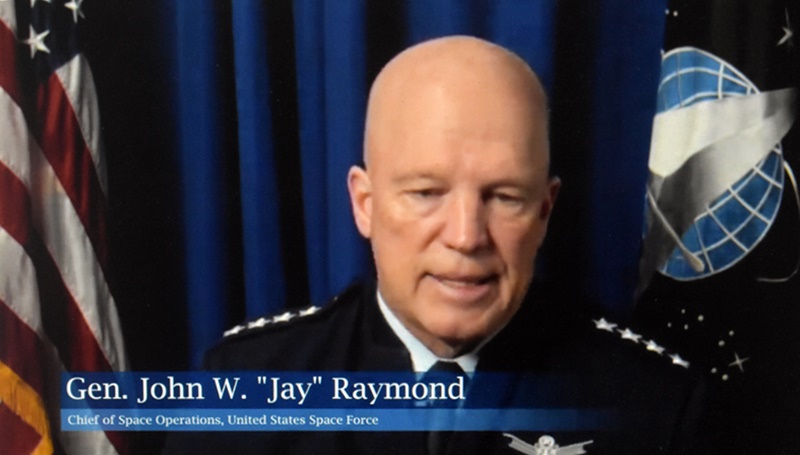Leader of U.S. Space Force says ability to move quickly sets newest military branch apart
Launched just over a year ago, the United States Space Force has been moving at warp speed to build an innovative and agile organization that will leverage allies and partners to accomplish its mission, said Gen. John W. “Jay” Raymond, chief of Space Operations, during a National Press Club Headliners Virtual Newsmaker event on March 3.

“We have to go fast. People ask me what keeps me awake at night. That would be the one thing that I would say, if there was something that kept me awake – it would be our ability to go fast,” the four-star general told Club Vice President Jen Judson who moderated the event.
The first new military service since 1947 was established in December 2019, when former President Donald Trump signed the 2020 National Defense Authorization Act into law.
In year one, Space Force leadership drafted a foundational doctrine, built cultural and identity items, and completed the largest reorganization in the history of a national-security enterprise. Two layers were slashed out of the command structure empowering fast response, 6400 tech-savvy airmen were competitively selected, and 10,000 civilians were assigned to the force.
According to Raymond, the blueprint for systems command to be unveiled in just weeks will emphasize a flat organization, the ability to move at speed, delegation of authority and unity of effort.
“Every person that comes to work with the Space Force comes to work with a heavy responsibility on their shoulders to get this right. And we are committed to doing so and committed to doing so at speed,” Raymond said.
The vastness of space -- the area of responsibility for space is 100 kilometers above the earth’s surface and higher -- and the speed at which operations take place, will require the Space Force to leverage the capabilities of U.S. allies and partners, Raymond said..
“Cooperation will be the hallmark of our approach to military activities in space. While our competitors are moving fast alone, we will go farther together with our partners and our allies,” Raymond said.
Space Force personnel, which are called Guardians, train, exercise, war game and operate with U.S. allies, Raymond said. For the very first time they are also building capabilities together and exploring the norms of responsible behavior in space.
The service has established data-sharing partnerships with allies, and struck deals with Japan and Norway to put hosted payloads onto satellites saving taxpayers almost $1 billion and achieving capability into orbit three years earlier.
Space Force has also engaged companies like SpaceX, which launches U.S. satellites on its rockets from Cape Canaveral, Florida, and Vandenberg Air Force Base, California. Raymond believes the innovative nature of the commercial industry – for instance SpaceX’s capability for rockets to autonomously sense if they are going astray and self-destruct – will help cut costs and increase efficiency.
“We want to have a very strong and tight-fused relationship with the commercial industry. We think it gives us great advantage,” Raymond said.
Time is of the essence in establishing these partnerships to ward off adversarial advances. “Access to space can no longer be treated as a given. The domain that enables our way of life is a contested domain,” Raymond said.
China has undertaken aggressive space-development programs over the last 15 years, Raymond said. Most concerning, he said is China’s development of technologies including jammers to block U.S. communication and GPS, and laser systems and ground missiles to damage or destroy satellites. Russia has similar capabilities.
“We are purpose-built to move at speed and to operate in this domain against this growing threat,” Raymond said.
At the same time, the Space Force is a force for global good, making the world safer for both allies and adversaries, Raymond said.
In 2007, China shot down one of its own satellites, creating a debris field of 3000 pieces that remains in space today. The Space Force plans to warn the Chinese if one of their satellites is about to hit one of the pieces of debris they created.
The branch tracks close to 27,000 objects in space, of which over 3,000s are active satellites – everything else is debris.
The Space Force “serves as the space traffic control for the world,” Raymond said. “We do all the analysis of every object that’s in space against every other object to make sure that two objects don’t collide to create more debris."
The newest military branch is showing no signs of slowing down in its mission to deter conflict from beginning in or extending into space.
“Now that we’re into year two, our focus is driving this car that we’ve built. And we need to drive it with our foot firmly planted on the accelerator to go fast,” Raymond said.
